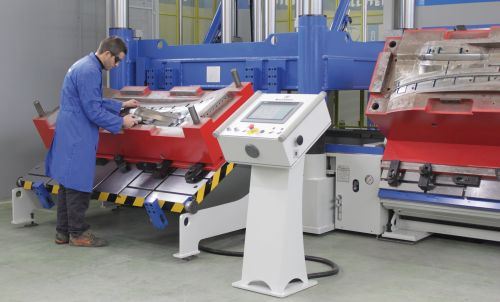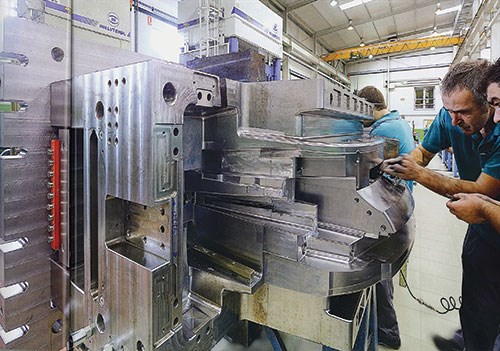The Hidden Value of a Spotting Press
As mold complexity increases, so, too, does the complexity of maintenance, which advances the role of spotting in mold validation.
In the highly competitive plastics industry, great emphasis is placed on precision, efficiency and productivity, but people often forget about the importance of completing the mold process. If a mold builder invests resources into high-precision machining, yet tests his molds using an overhead crane, how can he assure his customers that the molds are properly validated? With a high-precision spotting press, a mold builder can say, “This is how we know the mold is accurate.” This validation not only completes the mold process, it also provides the quality assurance of a premiere mold manufacturer.
As molds become more and more complicated, so does the checking and maintenance process. In turn, technology advances and so does the role of a spotting press to validate a mold. Having a high-precision spotting press provides a shop owner several advantages:
Safety. The first criteria in the design and manufacture of a spotting press should be safety. A high-precision spotting press minimizes dangerous mold handling associated with cranes, forklift trucks and other lifting equipment. Different from the mechanical multi-hole or toothed-bar system, a high-precision spotting press includes a safety device that prevents the press ram from falling if the hydraulic system fails. Safety devices are externally connected and always locked, which adds an extra safety measure.
Ergonomics. A high-precision spotting press is designed intrinsically with the maintenance crew in mind. Both platens should have the ability to tilt at varying angles, which helps avoid stressful maneuvers when performing mold maintenance by making the molds easily accessible. Some presses have a compact design that allows the mold maintenance technician to approach the mold from a variety of angles with a simple tap of a control touch panel. For example, a press with the upper platen rotating 360 degrees and the lower platen rolling out and then tilting 75 degrees. This same approach can be applied to medium and large molds where the upper platen withholds the capability of flipping 180 degrees and the lower platen rolls out, then tilts 70 degree to either the left or right. This allows workers to ergonomically adjust both platens with the benefit of working on the smaller side.
Productivity. Some shops use production molding presses to adjust a mold. This method is not only dangerous, it puts a strain on the adjuster. The reality is that molding machines need to be in production, as shops have targets they are required to meet. If a molding machine is
used for mold adjustment, the unplanned downtime will affect production. With a high-preci-
sion spotting press, the checking of high-quality molds can be completed quickly. As molds continue to be-come more and more complex (for example, multi-shot molds), a built-in rotational table on a high-precision spotting press allows shops to simulate mold production instead of taking up precious molding machine time. All in one setup, two-shot molds can be tested, adjusted and checked in a safe and simple manner, saving time and money.
Accuracy. High-precision spotting presses have high repeatability and accuracy. Trials can be further improved by testing hydraulic slides, auxiliary cylinders and ejectors. A parallelism control system can gauge the upper plate’s position to ensure an even stroke. Today, there is a lot of focus on mold accuracy, as many companies cut to net shape and negative stock on their cores and cavities. A parallelism control unit accurately brings the two halves together with precision. This technology features four electronic measurement devices, which continuously check the press’ upper plate position and parallelism while comparing it with the lower plate. Encoders are located diagonally in the four external corners of the upper plate with the columns. The measurements are displayed on a touch panel for the entire stroke. If the preset limit parameters are exceeded, the stroke’s movement is immediately disabled and the error is displayed. Parameters can be exceeded when hydraulic cylinders are not being retracted or tools are being left in the mold (for example, scrapers, grinders, slip gages and hammers). Smaller presses use optic scales to ensure the upper plate’s movement is even while the lower platen is locked into position.
Ease of use. Spotting operations of a high-precision press are intuitively controlled through a control touch panel that makes press functions clear, straightforward and simple. Additionally, the diagnostic program immediately reports on the display any anomalies that occur during operation. Each movement of the press is represented by a specific pictogram. In case of a malfunction, the relevant point is shown on the specific page for a quick solution. This helps minimize downtime, quickens troubleshooting and reduces service costs, especially after the warranty period.
Related Content
What is Scientific Maintenance? Part 2
Part two of this three-part series explains specific data that toolrooms must collect, analyze and use to truly advance to a scientific maintenance culture where you can measure real data and drive decisions.
Read MoreHands-on Workshop Teaches Mold Maintenance Process
Intensive workshop teaches the process of mold maintenance to help put an end to the firefighting culture of many toolrooms.
Read MoreThe Ins and Outs of Hot Runner Temperature Control
A training checklist that explains the why and how of proper hot runner temperature control and system management.
Read MoreLaser Welding Versus Micro Welding
The latest battle in finely detailed restoration/repair of mold materials.
Read MoreRead Next
Reasons to Use Fiber Lasers for Mold Cleaning
Fiber lasers offer a simplicity, speed, control and portability, minimizing mold cleaning risks.
Read MoreAre You a Moldmaker Considering 3D Printing? Consider the 3D Printing Workshop at NPE2024
Presentations will cover 3D printing for mold tooling, material innovation, product development, bridge production and full-scale, high-volume additive manufacturing.
Read MoreHow to Use Continuing Education to Remain Competitive in Moldmaking
Continued training helps moldmakers make tooling decisions and properly use the latest cutting tool to efficiently machine high-quality molds.
Read More






















